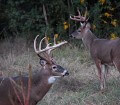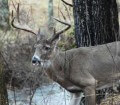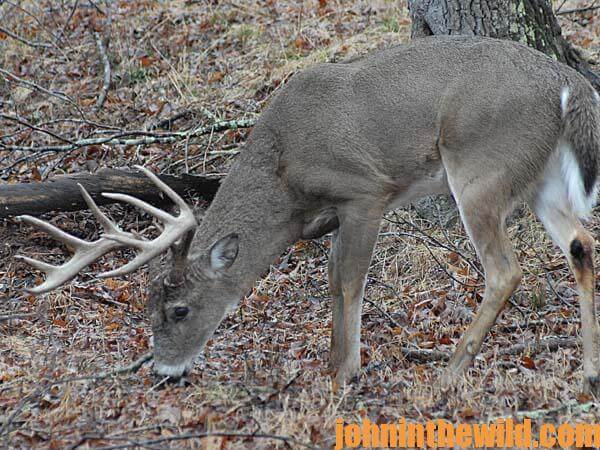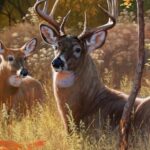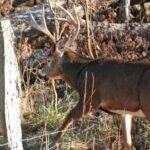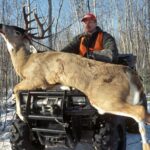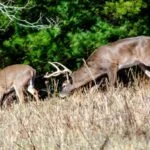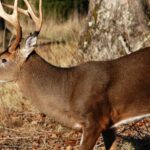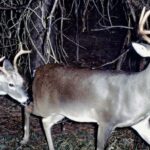John’s Note: The green fields that sly whitetail bucks shun during gun season are a different deal for early-season bowhunters. You can bet your hunt on it!
The morning had been cool. I was glad I had worn my underwear – even though the temperature was supposed to be in the mid-seventies by the middle of the day. The woods birds had just begun their morning chorus as I watched the sun cut diamond-shaped prisms through the dew on the painted fall leaves. Off to my right I saw an unusual little ear and a dark eye protruding out of a knothole in a tree just in front of me. The gray squirrel that peered back at me wasn’t quite sure what a strange-looking critter like me was doing all decked out in camouflage and hanging off the side of a tree. I felt sure the squirrel was wondering what I was, since I wasn’t there when he went to bed the previous night. But the squirrel must have concluded that whatever I was I couldn’t hurt the squirrel since it was high off the ground, and I was too big to fly. My reverie was broken when I heard a twig snap sharply. Whatever was off to my right was heavy. I just knew it had to be a deer, but I was afraid to move, thinking the animal might see me. Then I heard the telltale noise that convinced me my first assumption was correct. I heard an acorn pop.
Very carefully I turned to watch a doe and a spike chewing the acorns from a white oak tree some 30 yards away. Evidently the deer were having a snack on their way to the main meal of lush green in the field 20 yards ahead of them. Although the woods were still filled with acorns and plenty of browse, the deer seemed to prefer the winter wheat that had just begun to push its heads through the surface of the earth.
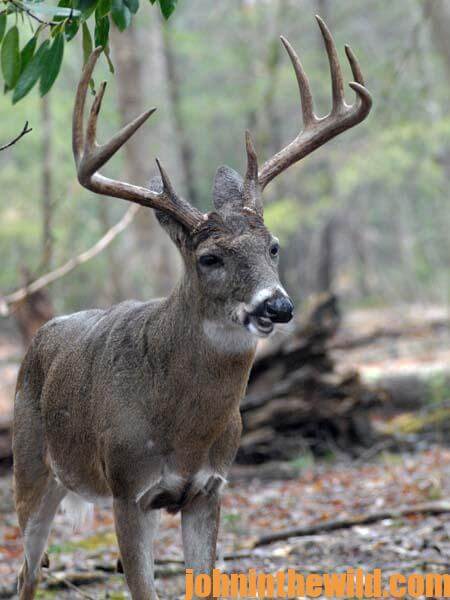 The two animals closed the distance between where I now stood at the ready with my bow. The wind was in my favor, and the deer were now at about 18 yards. While the animals had their heads down feeding, I drew my 55-pound bow and prepared for the shot. I kept my head down, felt the finger of my right hand anchor snugly into the corner of my mouth and made sure I put the pin sight about 3 inches behind the deer’s front shoulder. The shot felt good. Although the release was clean, the arrow completely missed the deer. When the broadhead struck the ground, the deer spooked and headed back into the woods.
The two animals closed the distance between where I now stood at the ready with my bow. The wind was in my favor, and the deer were now at about 18 yards. While the animals had their heads down feeding, I drew my 55-pound bow and prepared for the shot. I kept my head down, felt the finger of my right hand anchor snugly into the corner of my mouth and made sure I put the pin sight about 3 inches behind the deer’s front shoulder. The shot felt good. Although the release was clean, the arrow completely missed the deer. When the broadhead struck the ground, the deer spooked and headed back into the woods.
I couldn’t believe I had missed the shot – which was a simple shot, a textbook shot, a shot that I’d made a thousand times in my backyard. However, as I looked from my tree stand, I saw my arrow buried 1-1/2-feet deep in the ground. No deer was in sight. I mentally analyzed everything that had happened and looked again at the spot where I had released the arrow. There was the problem. While concentrating on my shot and making sure of my aim, I had failed to see a small twig directly in the path that the arrow had to travel. Probably my shaft had hit the twig and been deflected just enough to pass over the deer’s back. The shot was blown, the deer was gone, and I was somewhat disappointed, but not too disappointed. I had seen a deer, he had come to the spot I had predetermined he should come to, and I had had the opportunity to shoot. However, fate was on the deer’s side.
I believe that any time a hunter accurately can predict where and when a deer will show up, he’s had a successful hunt. Of course, he’s more successful if he takes the deer, but since I didn’t bag my deer, I considered myself moderately successful. In my case, the key to getting a shot came through close scrutiny of the green fields where I was hunting.
To understand where and when a deer will show up on a green field, there are a few things we must know about the field before we begin to hunt it. First realize that all green fields in early bow season will not have deer on them during daylight hours simply because they are green fields.
 Usually for a deer to feed in a green field during daylight hours, he must . . .
Usually for a deer to feed in a green field during daylight hours, he must . . .
* have quick access to dense cover;
* have very little hunting pressure; and
* be close to an area where he normally travels.
If the green field meets these criteria, then the chances are high that the deer will feed on the green field in daylight hours during hunting season – especially at the beginning of the season. The best way to determine if the deer are using green fields is to look for their tracks and droppings. Also the hunter’s trained eye may observe squared-off tips of plants where the deer have nipped the young, tender plants with their sharp front teeth while they were feeding.
Then, you must decide where the deer are entering and leaving a green field – information that can be gained by scouting the field right after a rainstorm. Look for deer tracks going in both directions – to and from the fields. The largest concentration of tracks going in both directions will be the point at which most of the deer are funneling in and out of the field. Oftentimes there will be more than one well-used trail coming into a green field. So, next I look down the trail that has the most cover and the best trees for a spot to place a tree stand.
Although we now have quite a bit of information about the green field we want to hunt, there is one-more critical factor that if overlooked often can ruin a hunt. We need to know in which direction the hunter can approach the trail he plans to hunt without having his scent carried to the deer. To gain this information, a compass and a GPS are essential. By using the compass, the hunter can determine under what wind conditions he may and may not hunt the best trail leading into and away from the green field.
To save time and to be sure I know where I should be hunting under what wind condition, I usually carry a small notepad with me on my scouting trips. I name each field and draw a diagram of the field on the notepad. I draw the place on the field where the trails come into the field and note what wind directions will be most favorable for me to hunt that green field on my map. I also put this information into my GPS, so that it’s readily available. Many of my friends prefer to use one of their deer-hunting apps on their phones.
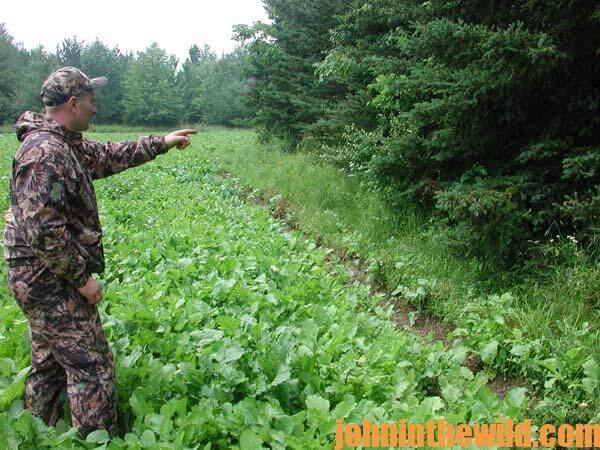 Prior to the season, I may diagram 15 to 20 fields in the area I hunt. Then with this information, I will make a small chart naming each field and the wind direction that I must have to hunt these fields. When I get ready to hunt, I want to know that my scent will not be carried across the trail or down the trail to spook the deer.
Prior to the season, I may diagram 15 to 20 fields in the area I hunt. Then with this information, I will make a small chart naming each field and the wind direction that I must have to hunt these fields. When I get ready to hunt, I want to know that my scent will not be carried across the trail or down the trail to spook the deer.
To get John E. Phillips’ Kindle eBooks and print books on hunting deer, “How to Hunt and Take Big Buck Deer on Small Properties,” “How to Hunt Deer Up Close: With Bows, Rifles, Muzzleloaders and Crossbows,” “PhD Whitetails: How to Hunt and Take the Smartest Deer on Any Property,” “How to Take Monster Bucks,” “How to Hunt Deer Like a Pro,” and “Bowhunting Deer: Mossy Oak Pros Know Bucks and Bows,” or to prepare venison, “Deer & Fixings,” click here.
For information on making jerky from your deer to provide a protein-rich snack, you can download a free book from https://johninthewild.com/free-books.

